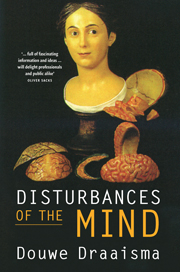Book contents
- Frontmatter
- Contents
- Introduction
- 1 Towards dusk the images appear
- 2 A tormenting round of tremors
- 3 Phineas Gage’s posthumous stroll
- 4 The Celestine prophesy
- 5 Sparks from a Leyden jar
- 6 Siberian brandy
- 7 Go to hell, idiot! Gilles de la Tourette syndrome
- 8 A labyrinth of tangles
- 9 The Mercator of neurology
- 10 The headquarters of madness
- 11 A cup of tea for the doppelgänger
- 12 Little professors
- 13 The Cardan suspension of science
- Index
- References
13 - The Cardan suspension of science
Published online by Cambridge University Press: 05 March 2014
- Frontmatter
- Contents
- Introduction
- 1 Towards dusk the images appear
- 2 A tormenting round of tremors
- 3 Phineas Gage’s posthumous stroll
- 4 The Celestine prophesy
- 5 Sparks from a Leyden jar
- 6 Siberian brandy
- 7 Go to hell, idiot! Gilles de la Tourette syndrome
- 8 A labyrinth of tangles
- 9 The Mercator of neurology
- 10 The headquarters of madness
- 11 A cup of tea for the doppelgänger
- 12 Little professors
- 13 The Cardan suspension of science
- Index
- References
Summary
In 1875, Jean-Martin Charcot celebrated his fiftieth birthday. He had spent the previous ten years at La Salpêtrière, where he focused his attention on diseases of the elderly and disorders of the nervous system. Charcot’s reputation was already established. He was the first to distinguish between multiple sclerosis (his coinage) and Parkinson’s disease; he identified amyotrophic lateral sclerosis (ALS, characterized by a rapid atrophy of muscle tissue, also known as Charcot’s disease); and described Charcot’s foot, a sudden softening of the bones of the foot as a result of nerve damage. Of the dozens of eponyms which include Charcot’s name, the majority refer to his work in neurology. He had been a member of the Académie de Médecine since 1872, but the prestigious membership of the Académie des Sciences lay years into the future. Much of what would determine how Charcot is remembered (his research into hysteria, the semi-public Leçons du Mardi, the theatrical hypnosis demonstrations) dates from the second half of the 1880s. In 1875, Charcot was first and foremost a neuroanatomist.
Like many physicians of his generation, Charcot was an excellent draughtsman, and many of his sketches have been preserved. He always encouraged his students to develop their drawing skills. He believed that drawing had a formative influence: it taught you to observe and to be attentive to details. A number of his doctoral students illustrated their own dissertations. And Charcot himself was often portrayed. In 1875, Brissaud, then still a student, secretly sketched the professor during an anatomy lecture. One of the senior physicians caught him at it, confiscated the drawing, and showed it to Charcot. Brissaud must have held his breath. The portrayal is of an overwhelming simplicity. Charcot is holding a brain in his hands and pointing out to his students something which is apparently on the underside. If he had not been wearing a high hat, he could easily have been mistaken for a butcher showing a customer his wares, before wiping his hands on his apron. Charcot had the drawing framed. Perhaps the one draughtsman had seen what the other was trying to express: concentration, hard work, an organ that only gives up its secrets to someone who is not afraid to dirty his hands.
- Type
- Chapter
- Information
- Disturbances of the Mind , pp. 326 - 352Publisher: Cambridge University PressPrint publication year: 2009



